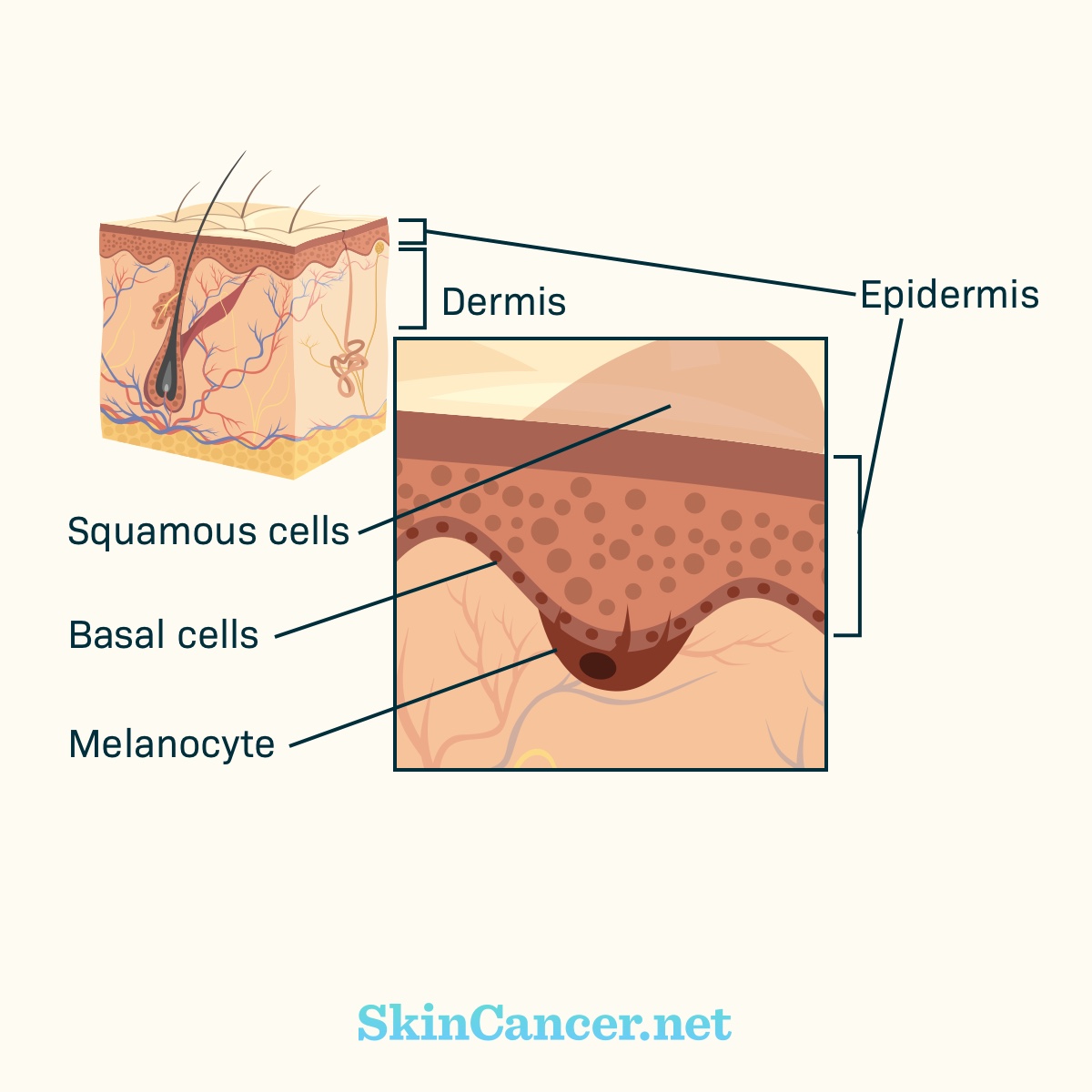Metastatic Melanoma
Reviewed by: HU Medical Review Board | Last reviewed: May 2017. | Last updated: June 2020
Melanoma develops when cells called melanocytes grow out of control. Melanocytes make the pigment that gives skin a tan or brown color. They are in the epidermis, which is the top layer of skin.
The term for melanoma that is entirely in the epidermis is called melanoma in situ. Approximately 40% of melanomas are diagnosed at this stage.1 If melanoma is not found early, it begins to grow downward through each layer of skin. It can enter the lymph vessels and spread through the body. The term for the spread of cancer cells from the original skin tumor to other parts of the body is metastasis.
Metastatic melanoma is also called stage IV melanoma or advanced melanoma.
How does metastatic melanoma spread?
To understand how melanoma invades and spreads, it helps to understand the layers of skin. The top layer is the epidermis (Figure 1).2 At the bottom of the epidermis is the “basement membrane.” The dermis is below the basement membrane. Below the dermis is subcutaneous tissue.
Figure 1. Layers of skin
Credit: Bliss D. 2005. National Cancer Institute Visuals Online.
Once melanoma has grown into the dermis, it can enter the lymph vessels. Lymph is a fluid that carries white blood cells.3 Lymph vessels transport lymph through the body (Figure 2). Lymph nodes are clusters of cells that act like a filter. They remove bacteria and other harmful substances.
Figure 2. Lymph nodes and vessels
Via the lymphatic system, melanoma cells can spread to distant parts of the body.4 In about 9% of cases, melanoma has spread to nearby lymph nodes at diagnosis.5 In 4% of cases, melanoma has already metastasized to distant locations in the body at the time of diagnosis.5
How is metastatic melanoma diagnosed?
If you have a suspicious mole or skin lesion, your doctor will remove the lesion. She or he will send the tissue sample (biopsy) to a laboratory.6 A pathologist will study it under a microscope to see if there are cancer cells.
If the skin biopsy shows that you have melanoma, then your doctor will perform additional tests. The purpose of these tests is to see if the cancer has spread. A lymph node biopsy is a test to see whether cancer cells have spread to the lymph nodes.
You also may need to have imaging tests to look for cancer in other parts of the body. Imaging tests include chest x-ray, computed tomography (CT) scan with or without positron emission tomography (PET), or magnetic resonance imaging (MRI).
A blood test will be done to check your lactate dehydrogenase (LDH) levels. LDH is an enzyme found in the blood. High LDH is a sign of cancer that is harder to treat.6
What are likely locations for melanoma metastases?
The most common location for secondary growths (metastases) are:7
- Under the skin (also called satellite metastasis)
- Distant lymph nodes
- Lungs
- Liver
- Brain
- Bones
Metastases can grow in other sites, although this is less common.7 The other possible sites include the adrenal glands, spleen, digestive tract, and heart.
How is metastatic melanoma treated?
Treatment options for metastatic melanoma include:8
- Immunotherapy
- Targeted therapy
- Chemotherapy
- Surgery
- Radiation therapy
Immunotherapies trigger your own immune system to destroy cancer cells.6Targeted therapies block the signaling molecules that cause a cancer cell to grow and divide. They target certain specific mutations that make cancers cells different from normal cells. This means that the side effects may be less severe than chemotherapy. Chemotherapy kills any cell that is dividing rapidly, whether it is a normal or cancerous cell. Chemotherapy is less common now because immunotherapy and targeted therapy are more effective.
Surgery is the first choice of treatment for early stage melanoma.6 It is also used to remove lymph nodes that contain cancer cells. Surgery does not usually cure metastatic cancer. However, surgery to remove metastases may improve symptoms. In some cases, it may prolong survival.
Radiation therapy is usually used with other treatments.6 The term for this is adjuvant therapy. Radiation kills cancer cells that remain after removing the lymph nodes. It can be used if cancer recurs. It may also be used to relieve symptoms caused by metastases.
What is the outlook for a person with metastatic melanoma?
For melanoma that has spread to nearby lymph nodes, the 5-year survival rate is 62%.5 This means that out of 100 people with regional melanoma, 62 will be alive 5 years after diagnosis.
The 5-year survival rate for metastatic melanoma is 18%.5 Survival is longer when metastases are found in the skin, subcutaneous tissue, or distant lymph nodes, compared with metastases found on internal organs.8 The outlook is better if LDH levels are normal.6
Why do some people participate in clinical trials?
New treatments, such as immunotherapies and targeted therapies, have helped to control melanoma and in some cases, prolong survival. Before the Food and Drug Administration approves a drug for use, the drug is studied in clinical trials.
Participating in a clinical trial may give you access to new treatment options. It is one option to consider if standard treatments are not working. However, clinical trials are not right for everyone. You and your doctor can discuss participating in a clinical trial.

